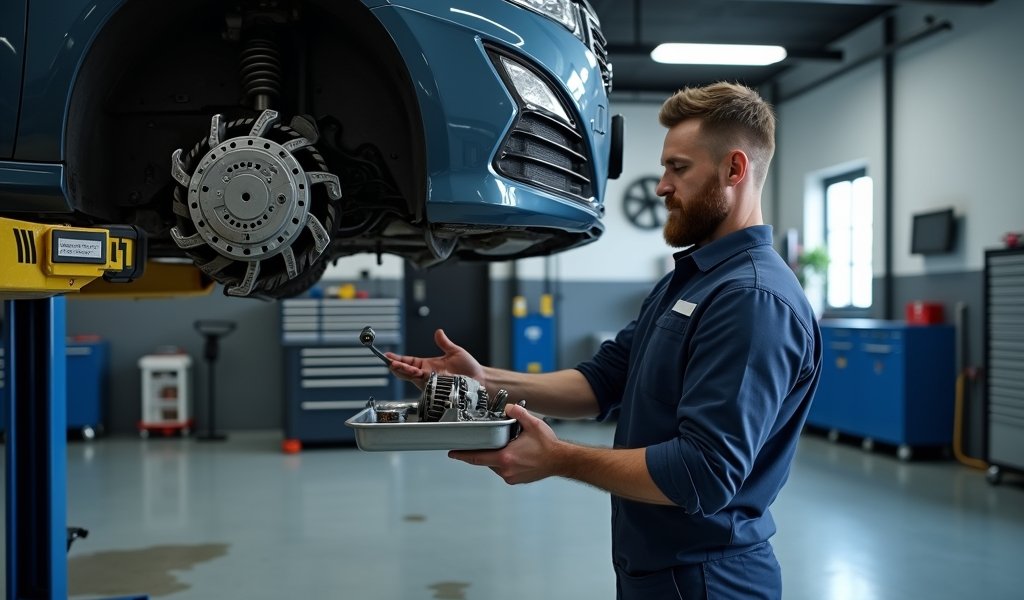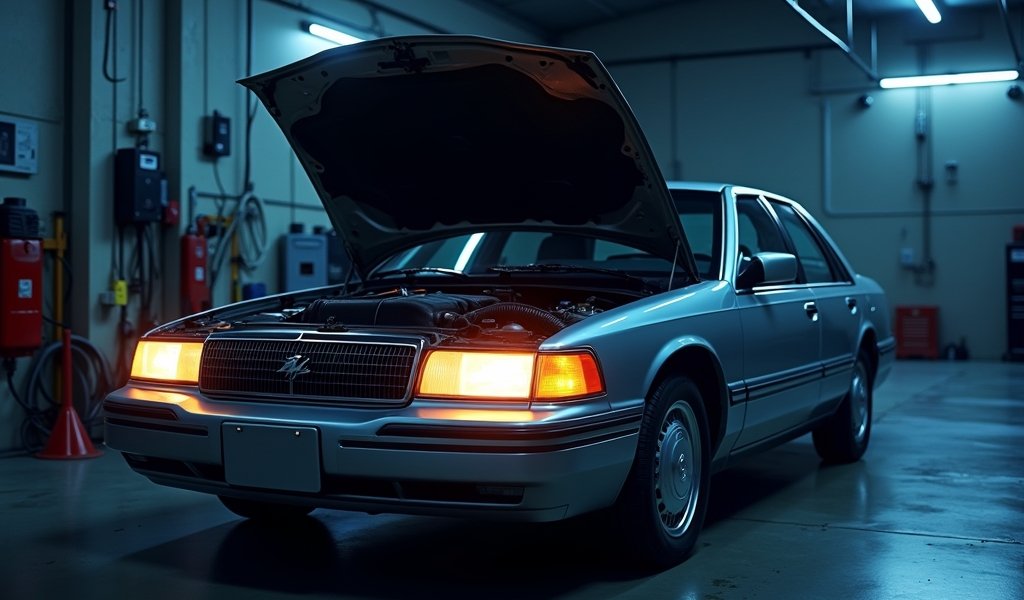Overview
This guide explains how to identify a failing alternator through seven key warning signs including dimming lights, dashboard warnings, electrical failures, strange noises, battery issues, burning smells, and engine performance problems. It provides practical diagnosis methods, seven proven fixes ranging from simple connection checks to complete replacement, and preventative maintenance tips to avoid alternator failures that could leave you stranded.
Table of Contents
- Introduction
- What Is an Alternator and How Does It Work?
- 7 Warning Signs of a Bad Alternator
- How to Diagnose Alternator Issues
- 7 Proven Fixes for Alternator Problems
- DIY or Professional Repair: What’s Best for You?
- Preventing Alternator Failure
- Conclusion
- Frequently Asked Questions
Introduction
Your car’s electrical system is like the nervous system of the human body – when it’s working perfectly, you hardly notice it. But when something goes wrong, particularly with your alternator, things can go south quickly.
The alternator is one of those unsung heroes under the hood. It silently keeps your battery charged and powers all the electrical components in your vehicle while the engine runs. When it starts to fail, it doesn’t always announce itself with a bang – instead, it whispers through subtle symptoms that are easy to miss.
As a mechanic with over 15 years of experience, I’ve seen countless drivers stranded due to alternator failures that showed warning signs for weeks or even months. The good news? These signs of a bad alternator are quite recognizable once you know what to look for.
In this guide, I’ll walk you through everything you need to know about spotting alternator problems early, diagnosing issues correctly, and implementing solutions that work. Whether you’re a weekend warrior who enjoys DIY car repairs or someone who prefers to leave it to the professionals, this information will help you make informed decisions about your vehicle’s electrical system.
What Is an Alternator and How Does It Work?
Before diving into the symptoms, let’s get familiar with what we’re talking about. Your alternator is essentially a generator that converts mechanical energy from the engine’s rotating crankshaft into electrical energy. This might sound complicated, but think of it as a mini power plant for your car.
When your engine runs, a drive belt (sometimes called a serpentine belt) spins a pulley on the alternator. Inside, a rotor spins within a stator, creating an alternating current (AC). This current passes through diodes that convert it to direct current (DC), which is what your vehicle’s electrical systems use.
While your battery provides the initial jolt of electricity to start your engine, the alternator takes over once the engine is running. It powers everything electrical – from your headlights and radio to your power windows and air conditioning. Simultaneously, it recharges your battery, ensuring it’s ready to start your car next time.
A typical alternator lasts between 80,000 and 150,000 miles under normal conditions, though this can vary based on driving habits, climate, and vehicle make. Modern alternators are remarkably efficient and reliable, but like all mechanical parts, they eventually wear out.

7 Warning Signs of a Bad Alternator
Catching alternator issues early can save you from being stranded and potentially save your wallet from the added cost of a tow truck or additional damage. Here are the telltale signs of a bad alternator you should never ignore:
1. Dimming or Flickering Lights
One of the most common and noticeable symptoms is dimming or flickering headlights and interior lights. Since your alternator powers your vehicle’s lighting system, any reduction in output will immediately affect brightness. You might notice your headlights seem dimmer than usual, especially at idle, or they might brighten and dim as you rev the engine.
This symptom is particularly evident at night or in low-light conditions. If your dashboard lights pulsate between bright and dim while driving, your alternator is likely struggling to maintain consistent output.
2. Warning Light on Dashboard
Most modern vehicles feature a dedicated alternator warning light on the dashboard. This might appear as a battery symbol, “ALT,” “GEN,” or sometimes directly as “CHARGE.” Don’t be fooled by the battery icon – this warning often indicates an alternator issue rather than a battery problem.
The light illuminates when your vehicle’s computer detects that the charging system voltage has fallen outside the acceptable range. While occasional flickering might happen during high electrical demand, a steadily lit warning deserves immediate attention.
3. Electrical System Failures
When your alternator can’t keep up with demand, various electrical components begin to fail or behave erratically. You might notice:
- Power windows operating more slowly than usual
- Radio or navigation system randomly shutting off
- Erratic behavior from dashboard instruments
- Power seats moving sluggishly
- Heating or cooling systems working inconsistently
These issues typically worsen as the alternator’s condition deteriorates. Your vehicle’s computer often prioritizes essential systems (like fuel injection and ignition) over comfort features, so you may notice non-critical items failing first.
4. Strange Noises
A failing alternator often announces its distress through unusual sounds. Listen for:
- A grinding noise (typically indicating worn bearings)
- A whining or squealing that changes pitch with engine RPM
- Intermittent rattling sounds from the alternator area
These noises originate from the front of the engine where the alternator is mounted. The pitch might change as you accelerate or decelerate, providing an audible clue that your alternator is the culprit rather than another component.
5. Battery Problems
Since your alternator charges your battery, a failing unit leads to battery depletion. Signs include:
- Difficulty starting your vehicle after it’s been running (indicating the battery wasn’t recharged during operation)
- Jump-starting works temporarily, but problems return quickly
- Battery warning light on dashboard
- Corrosion building up quickly on battery terminals
Many people mistakenly replace their battery when the real problem is the alternator. If you’ve recently installed a new battery that quickly lost its charge, your alternator is the likely culprit.
6. Burning Smells
An overworked alternator can overheat, creating a distinctive burning odor similar to electrical fire or hot rubber. This smell often results from:
- The belt slipping on the alternator pulley
- Internal components overheating
- Wiring insulation burning due to excessive current
This symptom requires immediate attention, as it can lead to complete electrical system failure or even vehicle fires in extreme cases. If you detect a burning smell along with other alternator symptoms, it’s wise to discontinue driving until the issue is addressed.
7. Stalling or Engine Performance Issues
In severe cases of alternator failure, your engine may stall completely. This happens because modern fuel-injected engines rely on electrical power for the fuel pump, fuel injectors, and ignition system. When the alternator cannot provide sufficient power, the engine struggles to perform properly.
Before complete failure, you might experience rough idling, hesitation during acceleration, or your engine might suddenly die while driving. These symptoms are particularly dangerous as they can occur in traffic or at highway speeds.
How to Diagnose Alternator Issues
Before you start replacing parts, it’s important to confirm that your alternator is truly the problem. Here’s how to diagnose alternator issues with increasing levels of precision:
The Battery vs. Alternator Test
One simple way to distinguish between battery and alternator problems is the “running disconnect” test. This should be done with caution as it can potentially damage sensitive electronics in modern vehicles, but it remains a quick diagnostic method:
- Start your vehicle and let it reach operating temperature
- With the engine running at idle, carefully disconnect the negative battery terminal
- If the engine dies immediately, your alternator isn’t generating power
- If the engine continues running, your alternator is likely functioning
For modern vehicles with complex computer systems, I recommend skipping this test and using the safer methods below.
The Voltage Test
For a more precise diagnosis, you’ll need a digital multimeter – an inexpensive tool that belongs in every DIYer’s toolbox. Here’s how to perform a basic voltage test:
- Set your multimeter to measure DC voltage (20V range)
- With the engine off, connect the multimeter to the battery terminals (red lead to positive, black to negative)
- Read the battery voltage – it should be around 12.4-12.7 volts
- Without disconnecting, start the engine
- Read the voltage again – it should increase to 13.8-14.7 volts
- If voltage stays below 13.5 volts with the engine running, your alternator is likely underperforming
- If voltage exceeds 14.8 volts, your voltage regulator may be faulty
For an even more thorough test, turn on your headlights, blower fan, rear defroster, and radio. The voltage should remain above 13.5 volts with these loads. If it drops significantly, your alternator cannot keep up with demand.
Professional Diagnosis
If you’re not comfortable performing these tests or want confirmation, ASE-certified technicians can provide comprehensive diagnosis. Professional testing includes:
- Computer diagnostics to check for stored trouble codes
- Load testing with specialized equipment
- Circuit testing to check for voltage drops
- Inspecting the drive belt and pulleys
A thorough car inspection will often catch alternator issues before they leave you stranded. Consider having your electrical system checked during your regular car service.
7 Proven Fixes for Alternator Problems
Once you’ve confirmed that your alternator is causing the issue, here are seven effective fixes, ranging from simple adjustments to complete replacement:

1. Check and Tighten Connections
Believe it or not, loose connections can mimic alternator failure. Start with the simplest solution:
- Ensure the battery terminals are clean and tight
- Check the alternator’s electrical connections
- Inspect the ground connections for security and corrosion
Loose connections create resistance that prevents proper charging and can trigger warning lights. A good cleaning and tightening may solve the problem without any parts replacement.
2. Inspect and Replace the Belt
The drive belt transfers power from the engine to the alternator. A worn, loose, or slipping belt can prevent the alternator from spinning at the correct speed:
- Look for cracks, glazing (shiny spots), or fraying on the belt
- Check belt tension – most belts should deflect about ½ inch when pressed
- Inspect the pulleys for damage or misalignment
- Replace the belt if it shows signs of wear or is more than 5 years old
Belt replacement is relatively inexpensive and can often restore proper charging system function if the alternator itself is still good.
3. Address Electrical Drains
Sometimes the problem isn’t the alternator itself but excessive electrical demand:
- Disconnect aftermarket accessories that might overload the system
- Check for parasitic drains that deplete the battery when the vehicle is off
- Look for damaged wiring that might be causing shorts
If your vehicle has numerous power-hungry accessories (high-output stereo, extra lighting, winches), you might need to upgrade to a higher-output alternator rather than just replacing the stock unit.
4. Clean Corrosion
Corrosion creates resistance that prevents proper charging:
- Disconnect the battery (negative terminal first)
- Clean battery terminals with a wire brush and baking soda solution
- Clean alternator connections using electrical contact cleaner
- Reconnect everything securely (positive terminal first)
Keeping electrical connections clean ensures maximum conductivity and can resolve intermittent charging issues.
5. Rebuild the Alternator
For the budget-conscious, rebuilding an alternator is an option:
- Typically costs 40-60% of a new unit
- Involves replacing worn brushes, bearings, and possibly the voltage regulator
- Can be performed by some auto parts stores or specialist rebuild shops
- Usually comes with a limited warranty (6 months to 1 year)
Rebuilding makes the most sense for older vehicles where a brand-new alternator might be expensive or hard to source.
6. Replace the Alternator
When other solutions don’t work, replacement is necessary. You have options:
- New OEM alternator (most expensive but highest quality)
- New aftermarket alternator (good balance of cost and reliability)
- Remanufactured alternator (budget-friendly option with decent reliability)
- Used alternator (cheapest but highest risk)
When replacing, always compare amp ratings to ensure the new unit meets or exceeds your vehicle’s requirements. This is particularly important if you’ve added electrical accessories.
7. Upgrade the Charging System
If you repeatedly face alternator issues, consider a system upgrade:
- High-output alternators provide more power for vehicles with additional electrical demands
- Upgraded wiring can reduce resistance and improve charging efficiency
- Dual-battery systems offer redundancy for critical applications
These upgrades cost more upfront but can prevent recurring problems for vehicles with demanding electrical requirements.
DIY or Professional Repair: What’s Best for You?
Deciding whether to tackle alternator replacement yourself depends on several factors:
When DIY Makes Sense
Consider the DIY route if:
- You have basic mechanical experience and tools
- Your vehicle has good access to the alternator
- You have a service manual or reliable online guide
- You can obtain quality parts with warranty
- You have backup transportation if complications arise
On many vehicles, alternator replacement is straightforward: disconnect the battery, remove the belt, disconnect the electrical connections, unbolt the alternator, and reverse the process with the new unit.
When to Call a Professional
Professional service is recommended when:
- The alternator is difficult to access (some require removing other components)
- You’re unsure about the diagnosis
- Special tools are required (some pulleys need specific tools to remove)
- Time constraints make DIY impractical
- You want warranty protection on both parts and labor
Professional alternator replacement typically costs $300-800, depending on your vehicle make, model, and location. While this exceeds the DIY cost, it includes labor, diagnostic certainty, and peace of mind.
According to Bureau of Labor Statistics, professional automotive technicians undergo thousands of hours of training – expertise that’s particularly valuable for complex electrical system diagnostics.
Preventing Alternator Failure
The best fix for alternator problems is preventing them in the first place. Here’s how to maximize your alternator’s lifespan:
Regular Maintenance
- Keep your battery terminals clean and tight
- Inspect belts regularly for wear and proper tension
- Keep the engine bay reasonably clean to prevent debris from affecting the alternator
- Address oil leaks promptly (oil can damage alternator windings)
- Have your charging system tested annually
Most reputable shops include charging system testing as part of a comprehensive car service checklist, but it’s worth specifically requesting if you’re concerned.
Smart Driving Habits
Your driving patterns affect alternator life:
- Limit short trips where the alternator doesn’t fully recharge the battery
- Avoid excessive idling with high electrical loads
- Turn off unnecessary electrical accessories when starting the engine in extreme cold
- Consider a battery maintainer for vehicles used infrequently
These simple habits reduce stress on your alternator and extend its service life considerably.
Be Proactive
Address minor symptoms before they become major problems:
- Investigate dashboard warning lights promptly
- Have strange noises diagnosed early
- Test your battery and alternator output annually
- Replace aging alternators preventively on high-mileage vehicles if you depend on reliability
According to AAA research, battery and electrical system failures remain among the top reasons for roadside assistance calls – most of which could be prevented with basic maintenance.
Conclusion
Recognizing the signs of a bad alternator early can save you from being stranded and prevent additional damage to your vehicle’s electrical system. From dimming lights and strange noises to warning lights and electrical failures, your car will give you clues that something’s amiss long before complete breakdown occurs.
Whether you opt for DIY repairs or professional service, addressing alternator issues promptly is crucial. The fixes we’ve covered – from simple connection checks to complete replacement – give you options based on your skill level, budget, and the severity of the problem.
Remember that prevention through regular maintenance remains your best defense. Keep an eye on your electrical system during routine service, address minor symptoms quickly, and drive with awareness of your vehicle’s electrical demands.
Next time your headlights dim or your battery warning light flickers, you’ll know exactly what to look for and how to approach the problem with confidence. Your alternator may be an unsung hero, but with proper care and attention, it will reliably power your adventures for many miles to come.
Frequently Asked Questions
How long can I drive with a failing alternator?
You can typically drive 30 minutes to an hour with a failing alternator, depending on your battery’s condition. Once the battery depletes, your vehicle will stall without warning.
Can a bad alternator damage my battery?
Yes, a faulty alternator can damage your battery by undercharging or overcharging it. Undercharging leads to sulfation while overcharging boils away electrolyte and warps internal plates.
How much does it cost to replace an alternator?
Alternator replacement typically costs $300-800, depending on your vehicle make and model. Parts range from $150-500, with labor adding another $150-300.
Can I jump-start a car with a bad alternator?
Yes, you can jump-start a car with a bad alternator, but it will only run until the battery charge depletes. Without a functioning alternator, the engine will eventually stall.
What’s the difference between alternator and starter problems?
Starter problems prevent the engine from turning over initially, while alternator problems occur after the engine is running. If your car starts but dies while driving, it’s likely the alternator; if it won’t start at all, suspect the starter.

